2016 National Breastfeeding Awareness Month
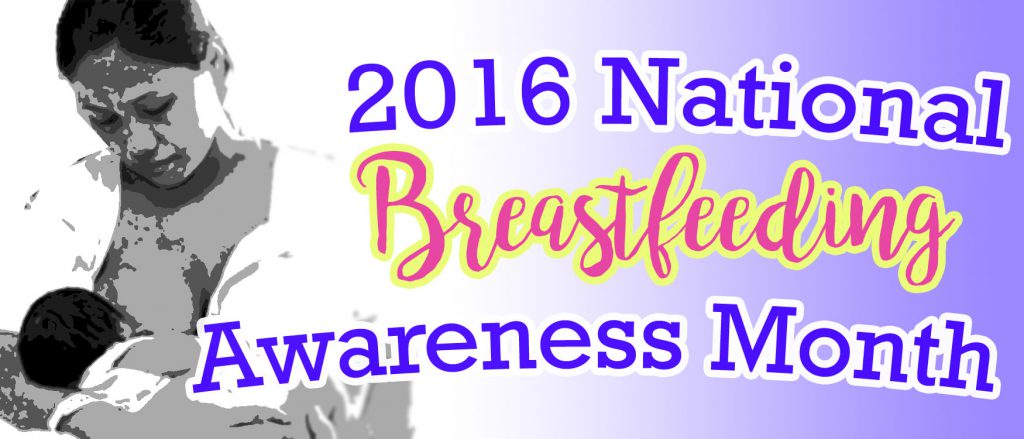
Theme: “Breastfeeding and Family Planning: Keys to Sustainable Development”
August 1-31, 2016
Pursuant to Republic Act (RA) 10028, otherwise known as the Expanded Breastfeeding Promotion Act of 2009, August of every year is Breastfeeding Awareness Month. This observance aims to raise public awareness on the importance of and to further promote breastfeeding in the country. Cognizant of the many benefits of breastfeeding to women and children, the Philippine Commission on Women (PCW) launched an Online Integrated Campaign which features successful breastfeeding stories and breastfeeding promotion initiatives from both public and private sector. Here’s your daily Breastfeeding 101. Be inspired and become a breastfeeding advocate now! #BreastfeedingMonthPH
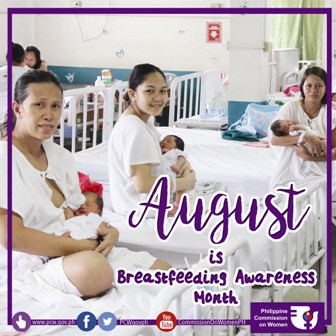
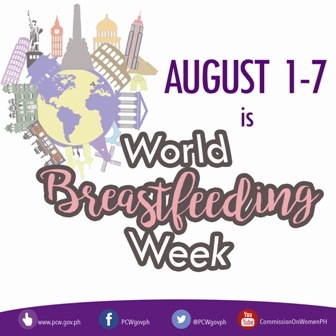
World Breastfeeding Week is being celebrated every year in 120 countries “consistent with the Innocenti Declaration on the Protection, Promotion and Support of Breastfeeding, the Baby-Friendly Hospital Initiative, the International Code on the Marketing of Breastmilk Substitutes and Related Products and subsequent resolutions of the World Health Assembly, to which the Philippines is a signatory.”
World Alliance for Breastfeeding Action (WABA), with the support from World Health Organization (WHO) and United Nations Children’s Fund (UNICEF) initiated this week-long observance which promotes exclusive breastfeeding for the first six months of life.
Source: Official Gazette
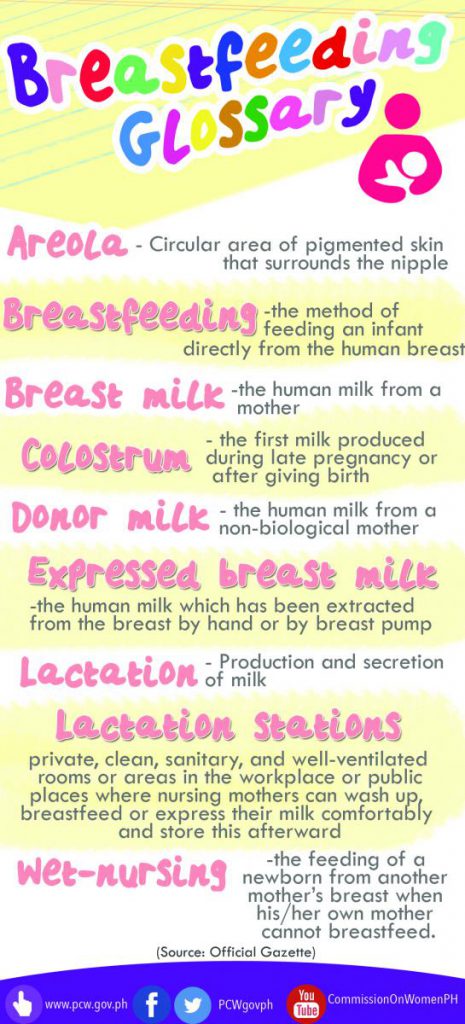
You Know the A to Z terms in Breastfeeding
For the complete list of terms, visit Official Gazette.
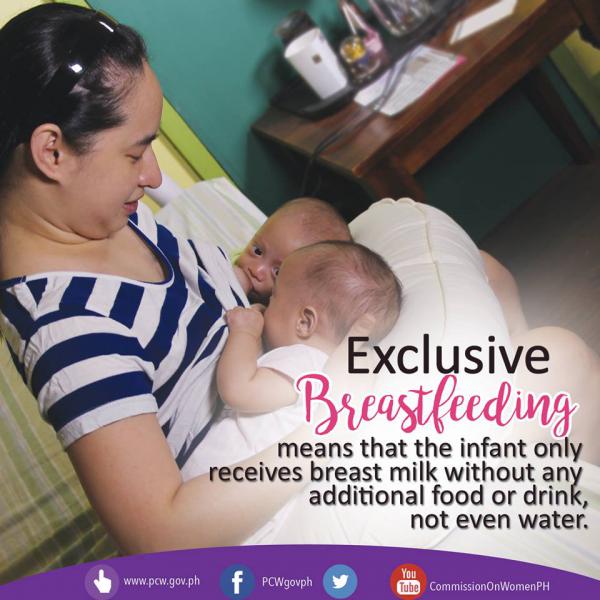
Exclusive breastfeeding is the process by which the infant receives only breast milk. No other liquids or solids are given – not even water – with the exception of oral rehydration solution, or drops/syrups of vitamins, minerals or medicines. According to World Health Organization (WHO), a newborn must be exclusively breastfed for at least six months. On the 7th month, mothers may opt to introduce solid food to their newborn yet can still continue breastfeeding until two years and beyond.
Source: World Health Organization
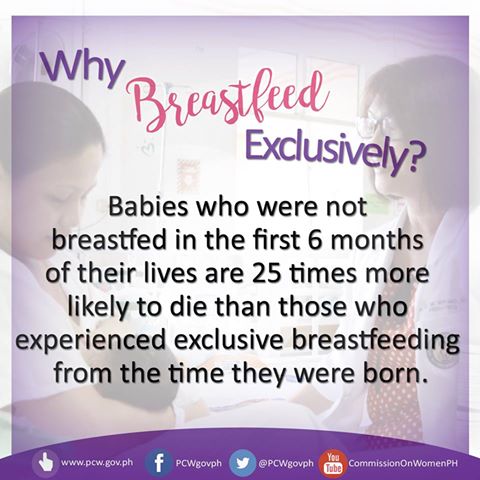
Why Breastfeed Exclusively?
Babies who were not breastfed in the first 6 months of their lives are 25 times more likely to die than those who experienced exclusive breastfeeding from the time they were born.
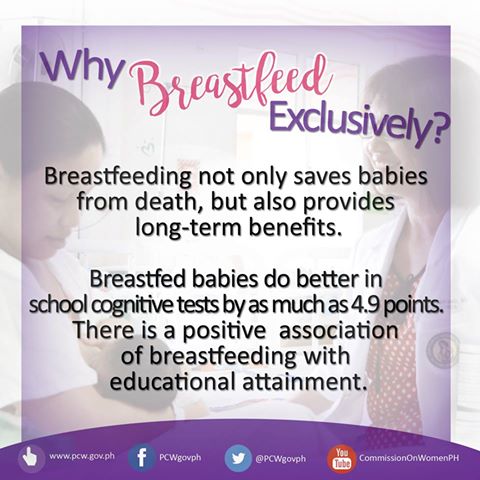
Breastfeeding not only saves babies from death, but also provides long-term benefits. Breastfed babies do better in school cognitive tests by as much as 4.9 points. There is a positive association of breastfeeding with educational attainment.
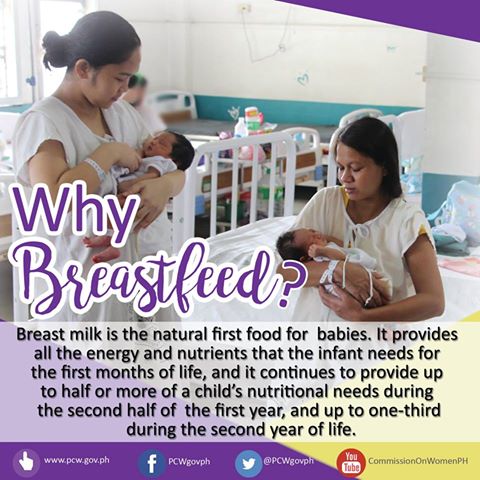
Source: World Health Organization
Why Breastfeed?
Breast milk is the natural first food for babies, it provides all the energy and nutrients that the infant needs for the first months of life, and it continues to provide up to half or more of a child’s nutritional needs during the second half of the first year, and up to one-third during the second year of life.
Source: World Health Organization
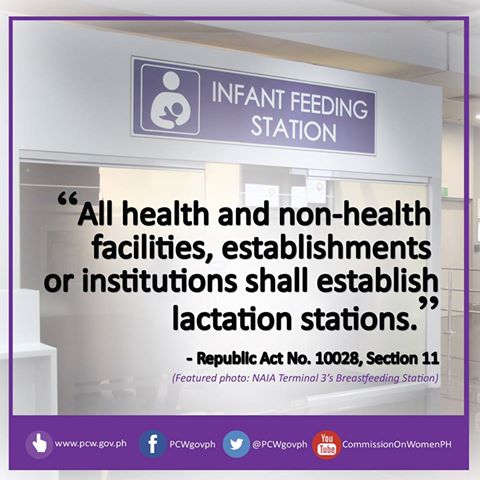
Have you checked the lactation stations in your nearby establishments lately? Pursuant to Expanded Breastfeeding Promotion Act of 2009 (RA 10028), all health and non-health facilities, establishments and lactation stations shall establish lactation stations. What is a lactation or breastfeeding station? Lactation station is a private, clean, sanitary, and well-ventilated room or area in the workplace or public place where nursing mothers can wash up, breastfeed or express their milk comfortably and store this afterward.
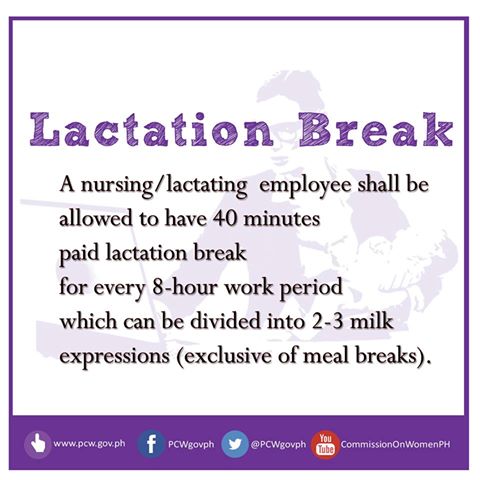
Lactation Break
Pursuant to Section 12 of the Expanded Breastfeeding Promotion Act of 2009, a lactating employee shall be “granted break intervals in addition to the regular time-off for meals to breastfeed or express milk. These intervals, which shall include the time it takes an employee to get to and from the workplace lactation station, shall be counted as compensable hours worked. The Department of Labor and Employment (DOLE) may adjust the same: Provided that such intervals shall not be less than a total of forty (40) minutes for every eight (8)-hour working period.”
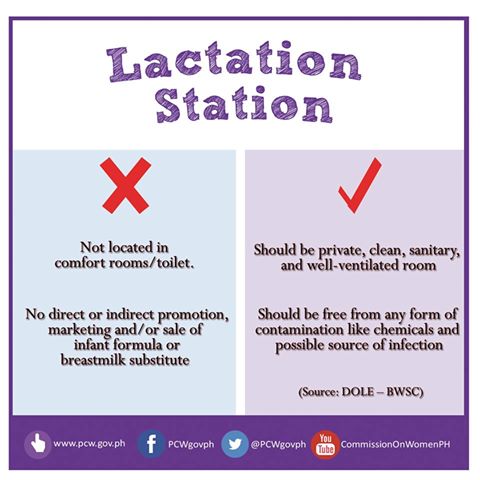
THE DO’s and DONT’s IN LACTATION STATIONS
A lactation station should have no direct or indirect promotion, marketing, and/or sale of infant formula or breast milk substitute.
A lactation station should be free from any form of contamination like chemicals and possible source of infection.
Source: Department of Labor and Employment – Bureau of Workers with Special Concerns
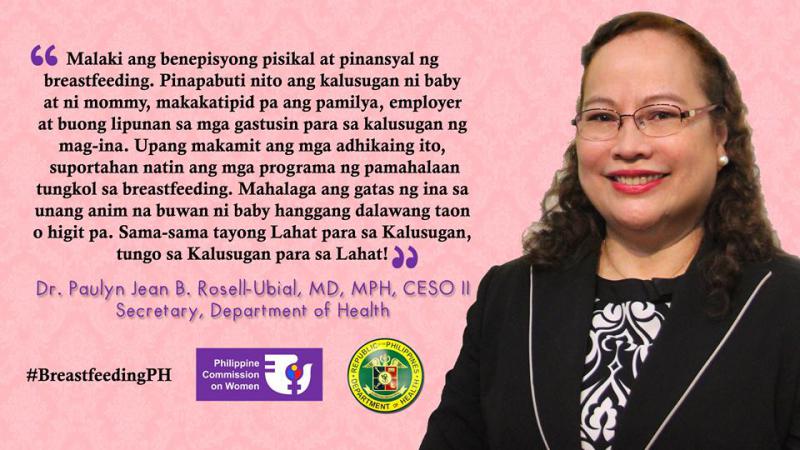
Department of Health (Philippines) Secretary Dr. Paulyn Jean B. Rosell-Ubial’s message on breastfeeding.
WATCH: Dr. Maria Carolina Mirano, Head of Breastfeeding Committee of Dr. Jose Fabella Memorial Hospital, discusses the importance of breastfeeding for mothers and babies.
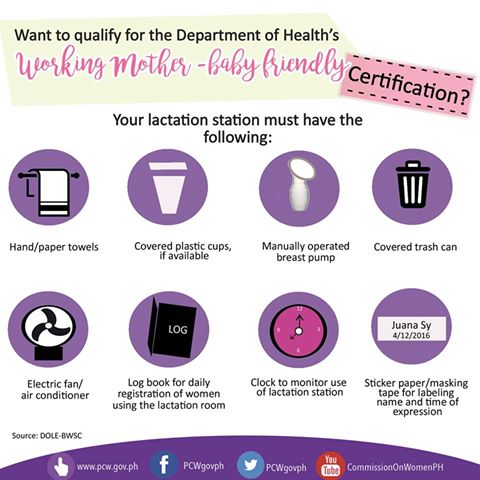
WORKING MOTHER-BABY FRIENDLY CERTIFICATION
Pursuant to Section 18 of the Expanded Breastfeeding Promotion Act of 2009, the Department of Health (DOH) shall issue a “working mother-baby friendly” certification to the establishments with proper lactation station.
Among the government organizations awarded with this certification are Dr. Jose Fabella Memorial Hospital, Landbank of the Philippines and Food and Nutrition Research Institute-Department of Science and Technology (FNRI-DOST).
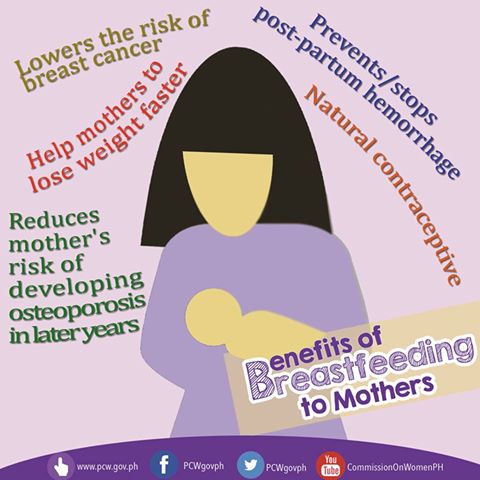
BENEFITS OF BREASTFEEDING TO MOTHERS
Did you know that breastfeeding also do wonders for mommies?
Aside from bringing special bond between mothers and their children, breastfeeding is believed to provide the following benefits to mothers:
- Lowers the risk of breast cancer
- Helps mother to lose weight faster
- Reduces mother’s risk of developing osteoporosis in later years
- Prevents/stops post-partum hemorrhage
- Natural contraceptive
Source: PCW’s Interview with Dr. Carolina Mirano of Dr. Jose Fabella Memorial Hospital
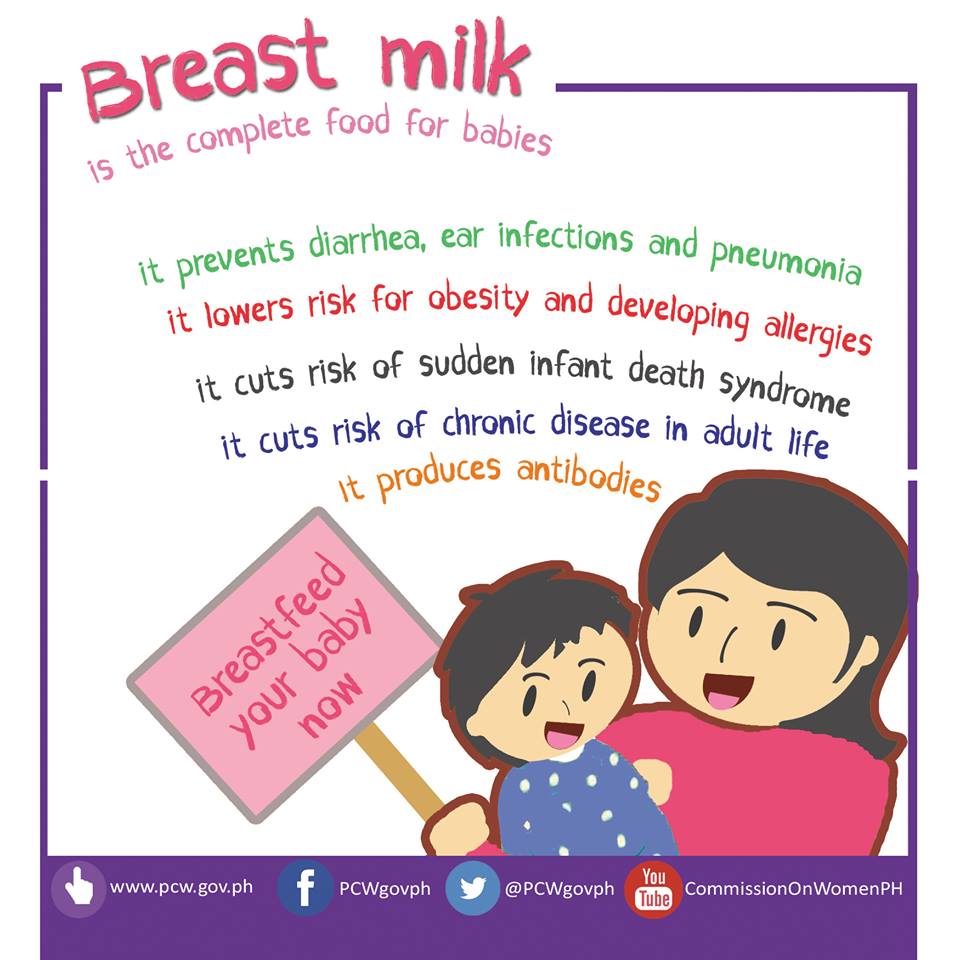
BENEFITS OF BREAST MILK
Did you know that breast milk prevents diarrhea, ear infections and pneumonia?It also lowers risk of obesity and developing allergies among babies! Wonder liquid, indeed!
Source: World Health Organization
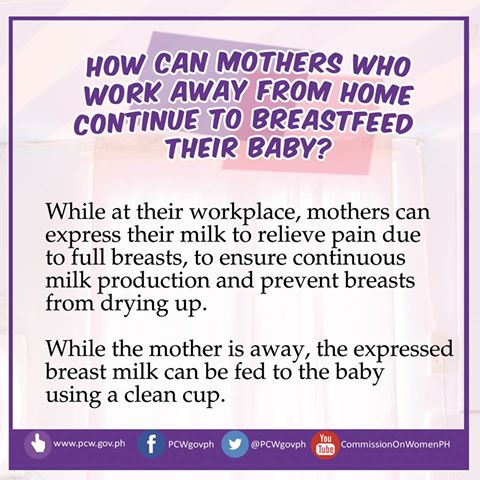
How can mothers who work away from home continue to breastfeed their baby?
Mothers can continue breastfeeding even when they have to report to work away from home. They can breastfeed her baby before leaving for work, after returning from work, at night and day-off or on weekends.
While at their workplace, mothers can express their milk to relieve pain due to full breasts, to ensure continuous milk production and prevent breasts from drying up. While the mother is away, the expressed breast milk can be fed to the baby using a clean cup.
Source: Department of Health
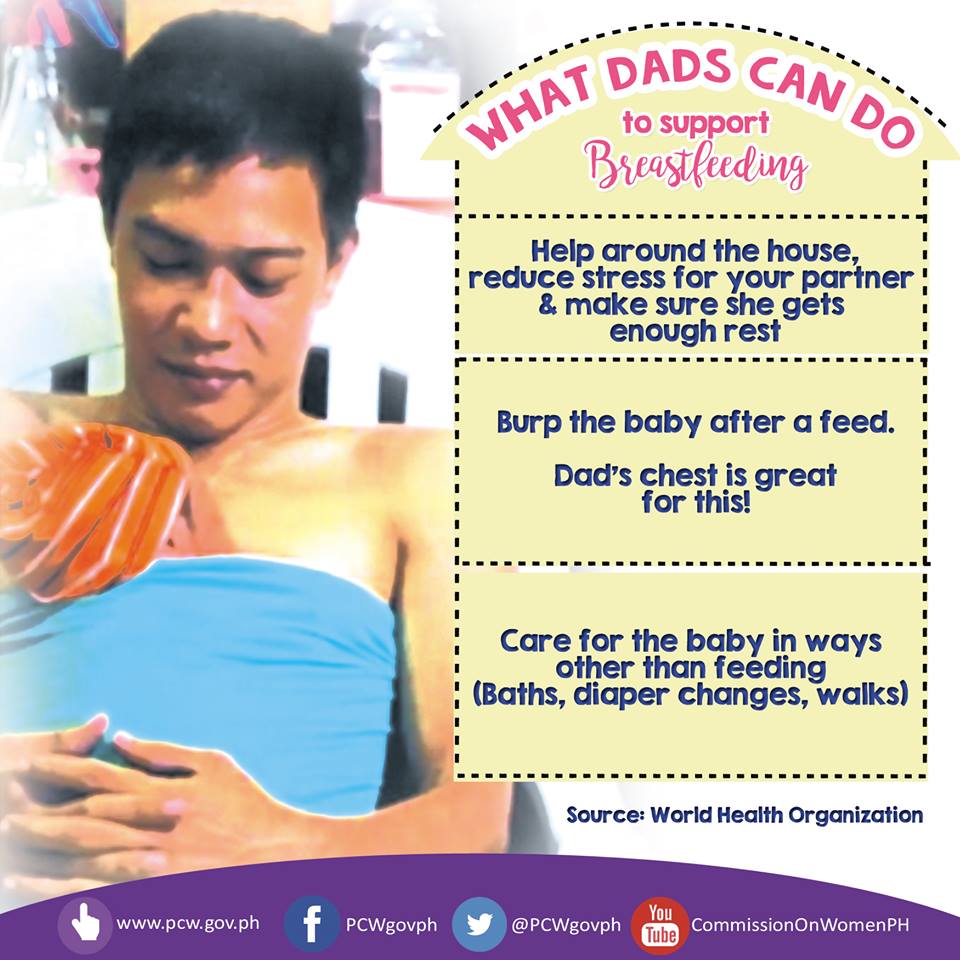
WHAT DADS CAN DO TO SUPPORT BREASTFEEDING
Daddies, you have a role too!
How can you help your breastfeeding partner?
- Help around the house, reduce stress for your partner and make sure she gets enough rest
- Burp the baby after a feed
- Care for the baby in ways other than feeding
Source: World Health Organization
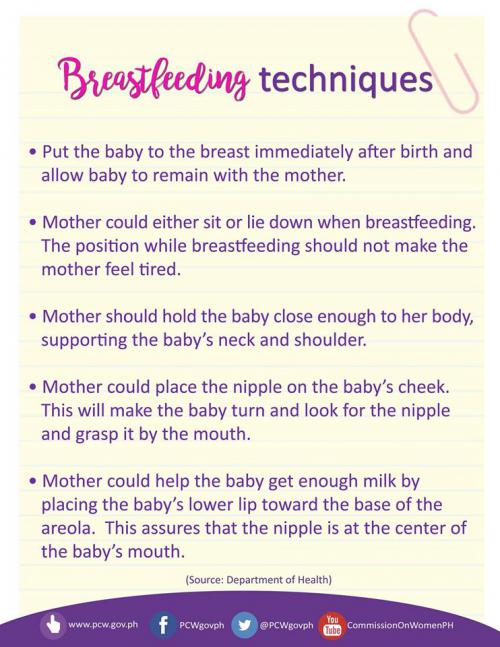
These are some techniques that make breastfeeding more effective:
- Put the baby to the breast immediately after birth and allow baby to remain with the mother.
- Mother could either sit or lie down when breastfeeding. The position while breastfeeding should not make the mother feel tired.
- Mother should hold the baby close enough to her body, supporting the baby’s neck and shoulder.
- Mother could place the nipple on the baby’s cheek. This will make the baby turn and look for the nipple and grasp it by the mouth.
Source: Department of Health
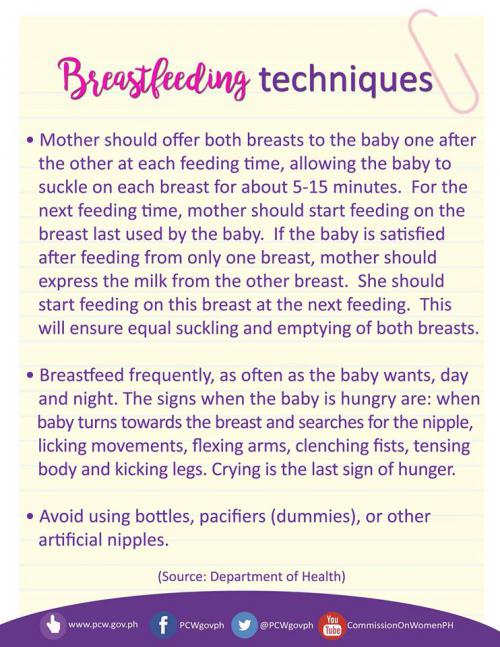
ADDITIONAL BREASTFEEDING TECHNIQUES
These are the additional techniques that make breastfeeding more effective:
- Mother should offer both breasts to the baby one after the other at each feeding time, allowing the baby to suckle on each breast for about 5-15 minutes.
- For the next feeding time, mother should start feeding on the breast last used by the baby. If the baby is satisfied after feeding from only one breast, mother should express the milk from the other breast. She should start feeding on this breast at the next feeding. This will ensure equal suckling and emptying of both breasts.
- Breastfeed frequently, as often as the baby wants, day and night. The signs when the baby is hungry are: when baby turns towards the breast and searches for the nipple, licking movements, flexing arms, clenching fists, tensing body and kicking legs. Crying is the last sign of hunger.
- Avoid using bottles, pacifiers (dummies), or other artificial nipples.
Source: Department of Health
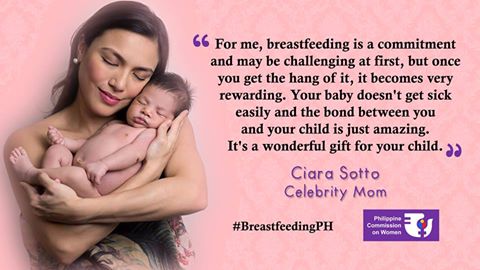
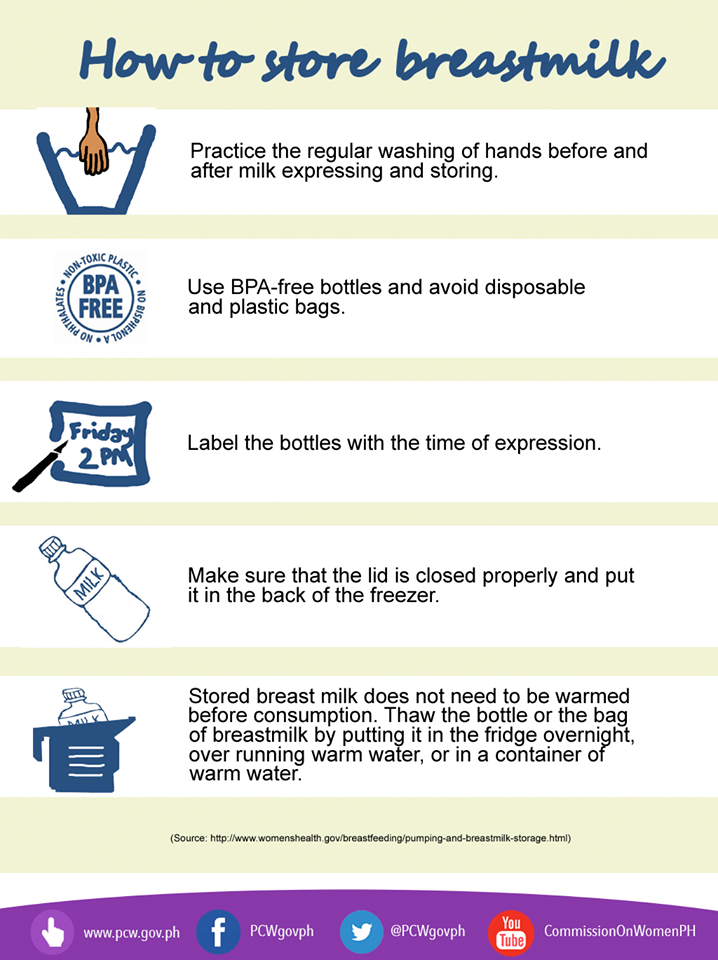
How to store breastmilk?
- Practice the regular washing of hands before and after milk expressing and storing.
- Use BPA-free bottles and avoid disposable and plastic bags.
- Label the bottles with the time of expression.
- Make sure that the lid is closed properly and put it in the back of the freezer.
- Stored breast milk does not need to be warmed before consumption. Thaw the bottle or the bag of breastmilk by putting it in the fridge overnight, over running warm water, or in a container of warm water.
Source: Women’s Health
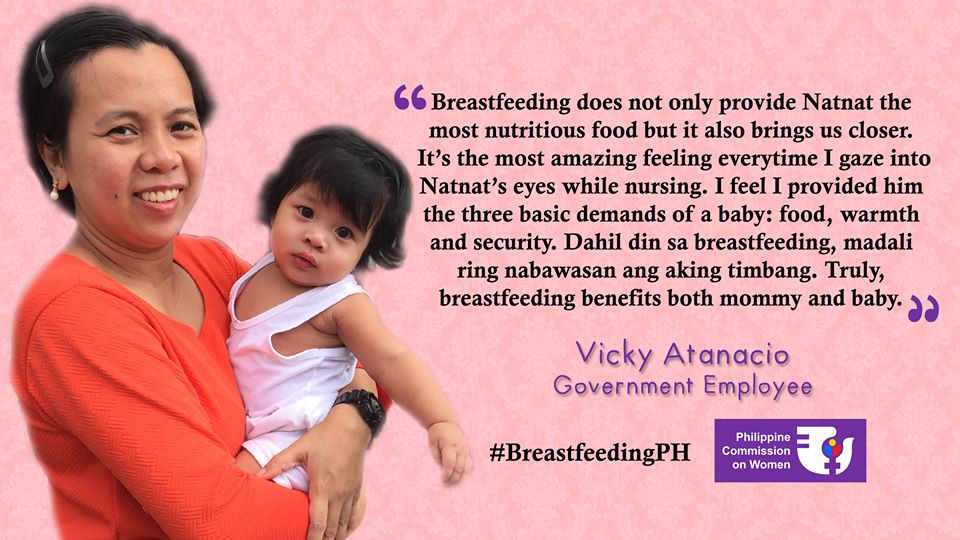
Vicky Torres Atanacio, government employee and a mother of two, shares why breastfeeding is beneficial for both mommy and baby.
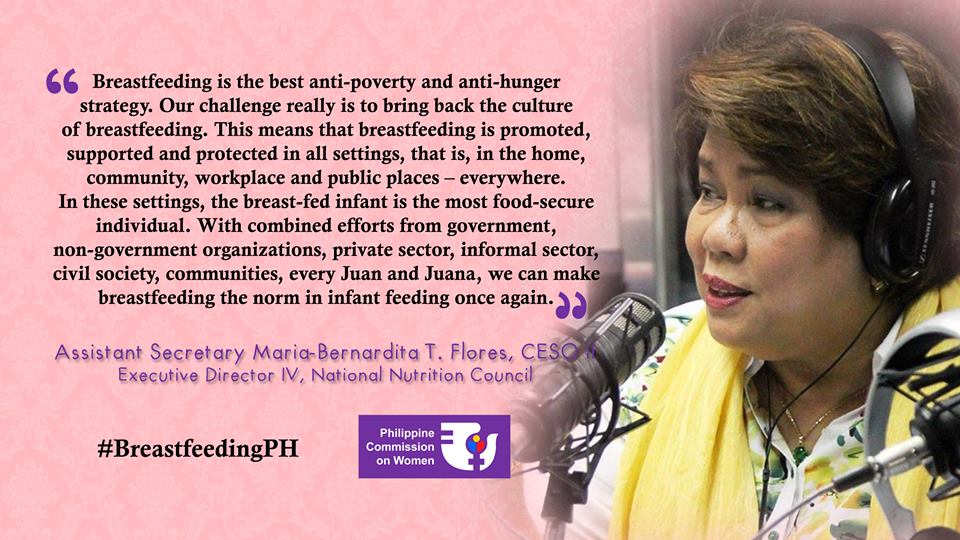
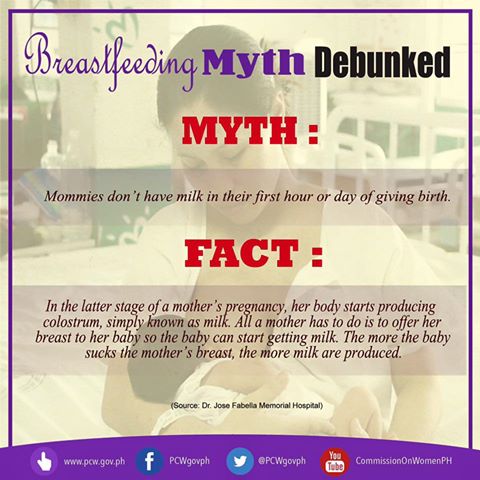
Debunking Breastfeeding Myth #1: In the latter stage of a mother’s pregnancy, her body starts producing colostrum, simply known as milk.
This is according to Dr. Maria Carolina Mirano, the Chair of Mother-Baby Friendly Hospital Initiative of Dr. Jose Fabella Memorial Hospital.
Therefore, a mother has available milk in her first hour or first day of giving birth. All a mother has to do is to offer her breast to her baby so the baby can start getting milk.
Dr. Mirano also said that the more the baby sucks the mother’s breast, the more milk are produced.
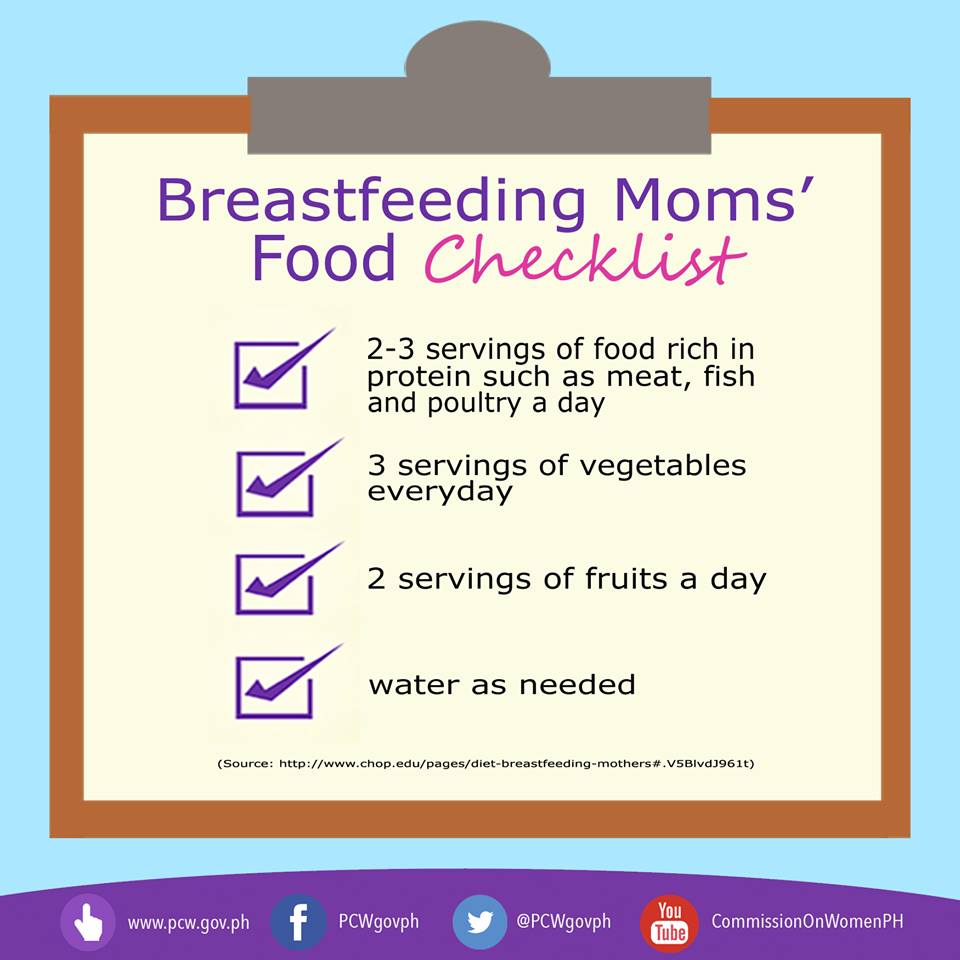
For a breastfeeding mommy, an intake of 2-3 servings of food rich in protein such as meat, fish and poultry a day is recommended.
Additionally, they also need 3 servings of vegetables and 2 servings of fruit daily. These extra calories are needed for milk production.
Lactating mothers should also drink water as needed.
Source: Children’s Hospital of Philadelphia
Feature:
Feature: Breastfeeding Station in Robinsons Magnolia
WATCH: Ms. Mylene A. Del Rosario, Regional Operations Manager of Robinsons Magnolia, discusses the importance of setting breastfeeding stations in public places

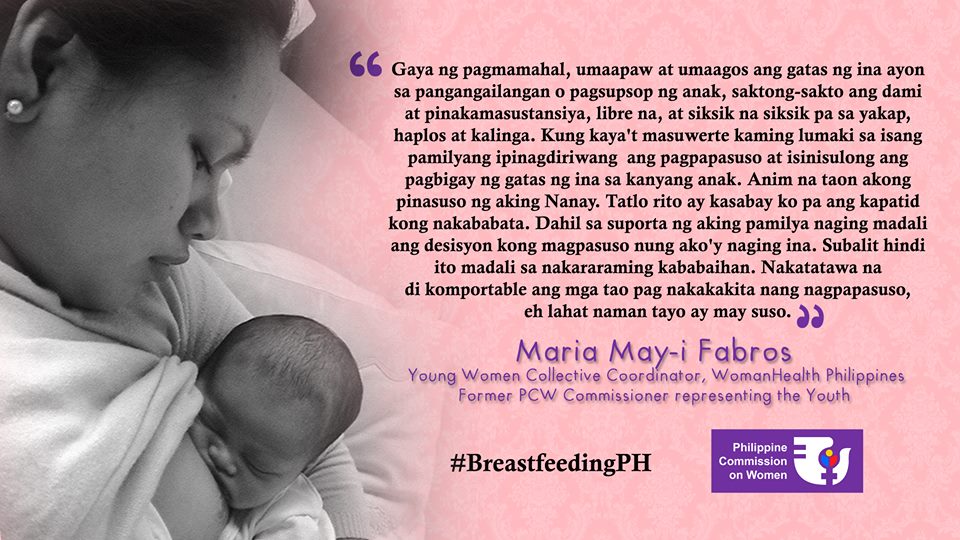
Maria May-i Fabros, Young Women Collective Coordinator of WomanHealth Philippines, shares her insight on breastfeeding.
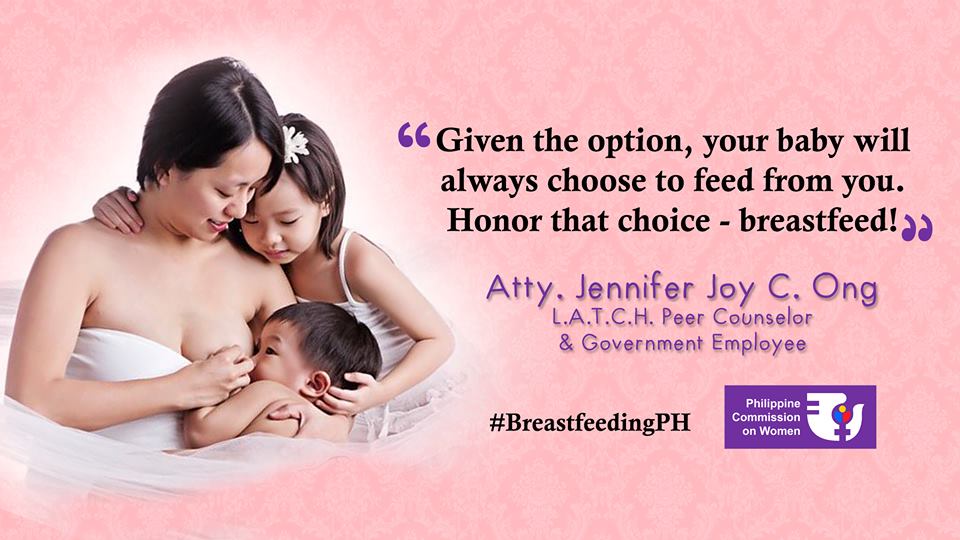
Atty. Jennifer Joy C. Ong, LATCH Peer Counselor and Government Employees, shares her insight on breastfeeding.
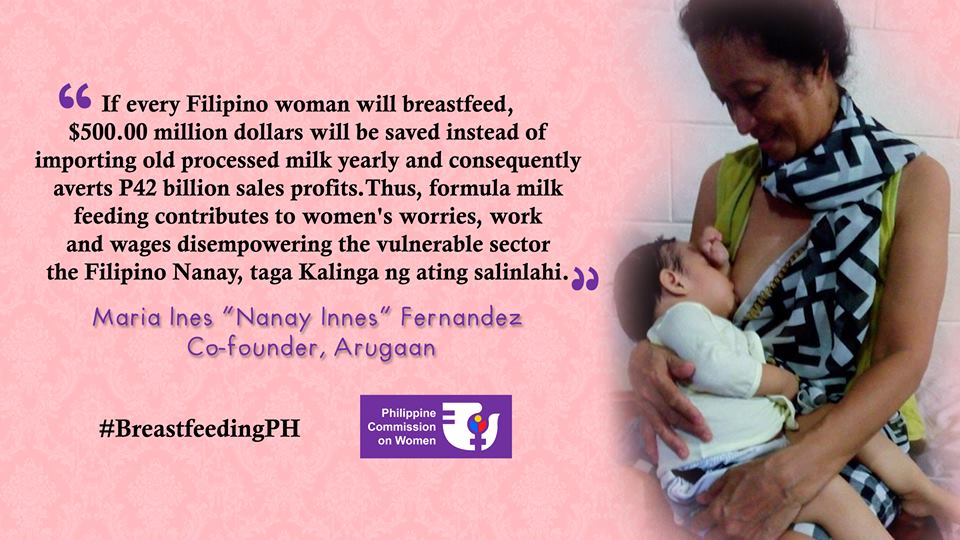
Innes Fernandez, co-founder of Arugaan, believes that breastfeeding empowers women.
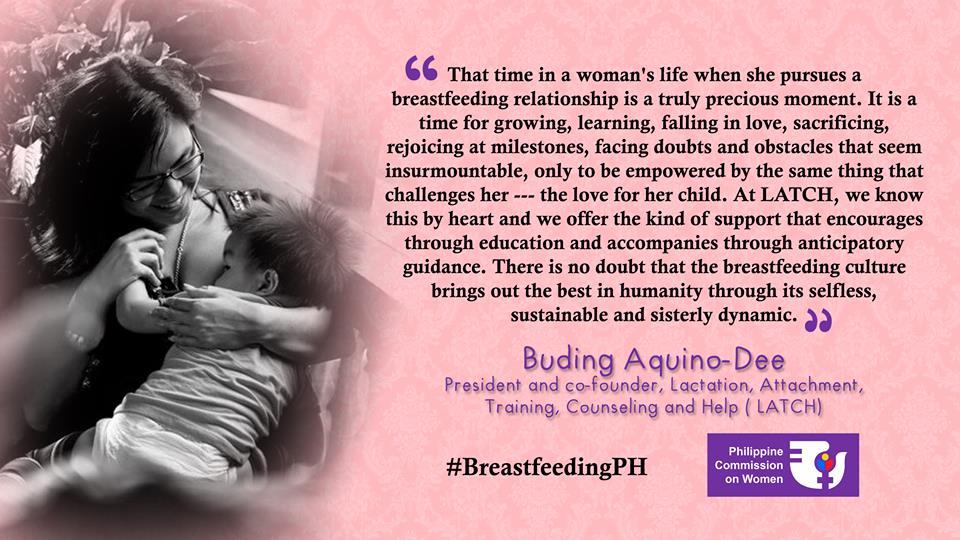
Buding Aquino Dee, President and co-founder, Lactation, Attachment, Training, Counseling and Help (LATCH) shares her insights on breastfeeding.
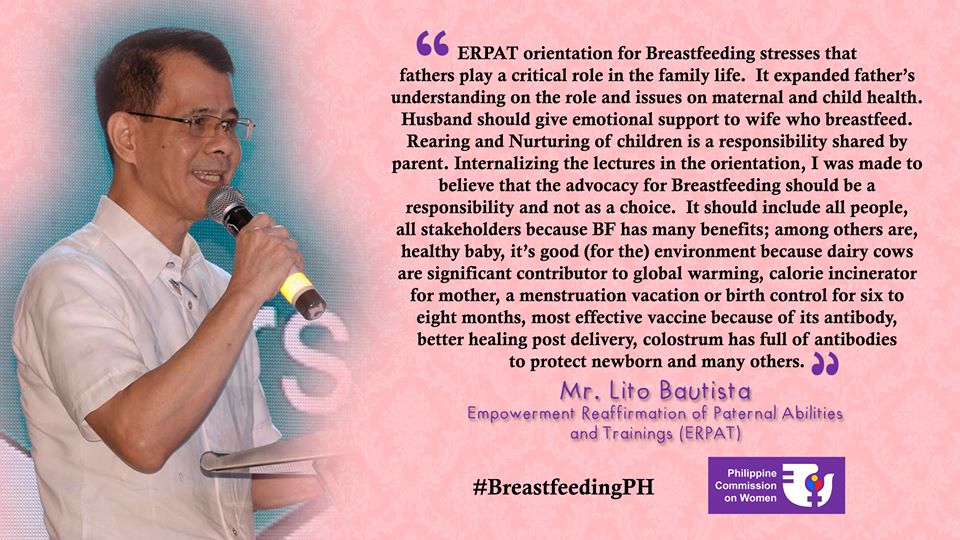
Mr. Lito Bautista of Empowerment Reaffirmation of Paternal Abilities and Trainings (ERPAT) believes that breastfeeding is a responsibility and not a choice.

Judith Lacanaria from Bacoor, Cavite believes that breastfeeding makes her newborn child healthier and stronger. Watch full video here.

Did you know that some bus companies have set up their breastfeeding stations too? Watch full video here.
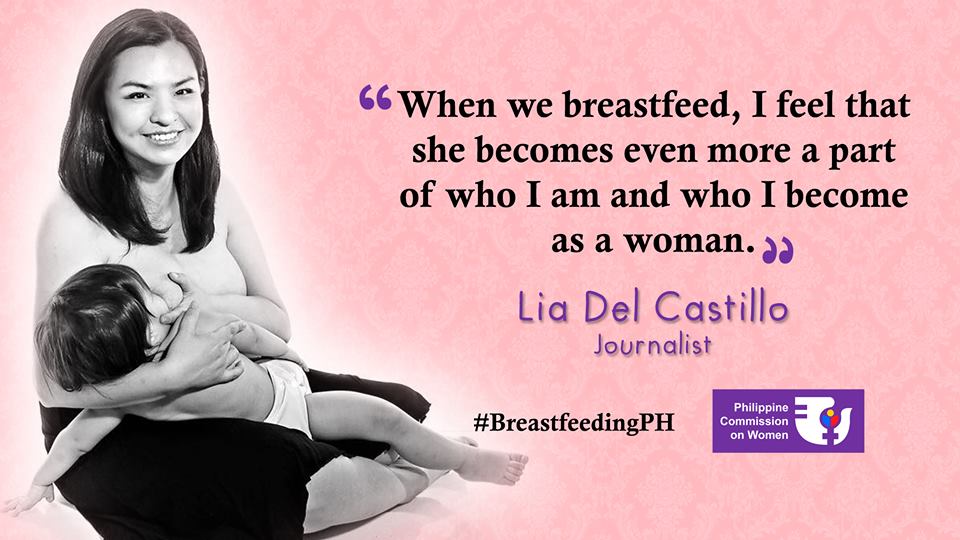
This is what Journalist Lia Mañalac-del Castillo feels about breastfeeding.


